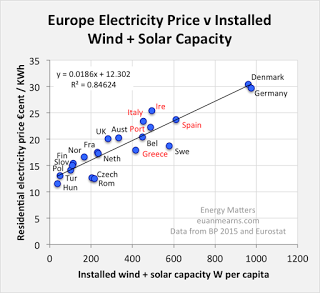Total UK primary energy consumption is the equivalent of around 2200 tw/h per year, of which electricity accounts for around 350 tw/h. This illustrates our reliance on fossil fuels and the mountain we face if we want to reduce and eliminate them.
We have two models in Europe we can already compare on how we might go about trying.
France has low cost (12p kw/h), low CO2 electricity, 75% of which is supplied by nuclear power plants.
Germany on the other hand shows that even a limited penetration of wind and solar (3.5% of total primary energy consumption) leads to high electricity prices. Getting on for double that of France at 23p kw/h. It’s energy companies have also been suffering record losses.

Energy taxes and subsidies more or less cancel themselves out. Graph above taken from Euan Mearns
The system costs incurred by dispersed , intermittent wind and solar rise with market share. So, if fossil fuels are to be reduced in any meaningful way, wind and solar will be a cripplingly expensive way of doing it.
Only nuclear can power a modern economy at reasonable cost free from fossil fuels. But due to the large upfront capital costs it has to be planned and financed in the way the French did. Settle on one design, build lots of them quickly, and finance them from Government bonds.
French nuclear supplies electricity at a wholesale price a third of what Hinkley Point C is being offered. It also exports £3bn a year of it at profit.
There is no reason whatsoever that we should ever pay a penny more for our energy than the French are now. That means a reduction in our current bills.
Areva took an existing design, and added more systems and defence in depth. This has proved difficult to build, and it the reason why EDFs finances are in such bad shape.
As reported recently, the Hitachi ABWR could come in at £70 mw/h, when privately financed. Good, but we can do better.
GE-Hitachi have taken that design and gone in the opposite direction of Areva by simplifying and modularising it. The ESBWR has been approved by the American regulators, and is reported to be the safest reactor to get such approval. Designed to be easier to construct, it also has the lower operating costs.
If the UK built twenty of these, over 15 years, financed by bonds, we can benefit from learning curve cost reductions in exactly the same way the French did.
Having a standardised fleet, rather than the nuclear zoo we are currently on course to build, would have other cost and safety advantages too.
Furthermore, there is new fuel technology currently undergoing regulatory approval that can further cut costs and increase safety. For example Lightbridge all metallic fuel rods can increase power by 30% in a new build reactor, while reducing the fuels operating temperature.
Reactors can make hydrogen from electrolysis or thermochemistry, to power fuel cells or existing gas turbines. High temperature reactors(FHRs), being developed and commercialised in China and the US, can substitute for natural gas using the air Brayton cycle(NACC), thereby reusing existing CCGT infrastructure. This also gives them faster ramping up rates than any current available technology, making them the perfect partner for the limited load following of BWRs.
High temperatures can make CO2 neutral synthetic fuels, using the existing infrastructure for internal combustion engines.
And all nuclear power stations produce lots of hot water as waste, which could instead be used as district heating, making use of the hot water systems most UK households have for gas central heating.
We cannot afford the costly grid and infrastructure upgrades needed in order to accommodate a wind, solar and battery economy.
France has shown us that cheap CO2 free energy is doable. We should copy their example, just don't buy their EPR reactor.
